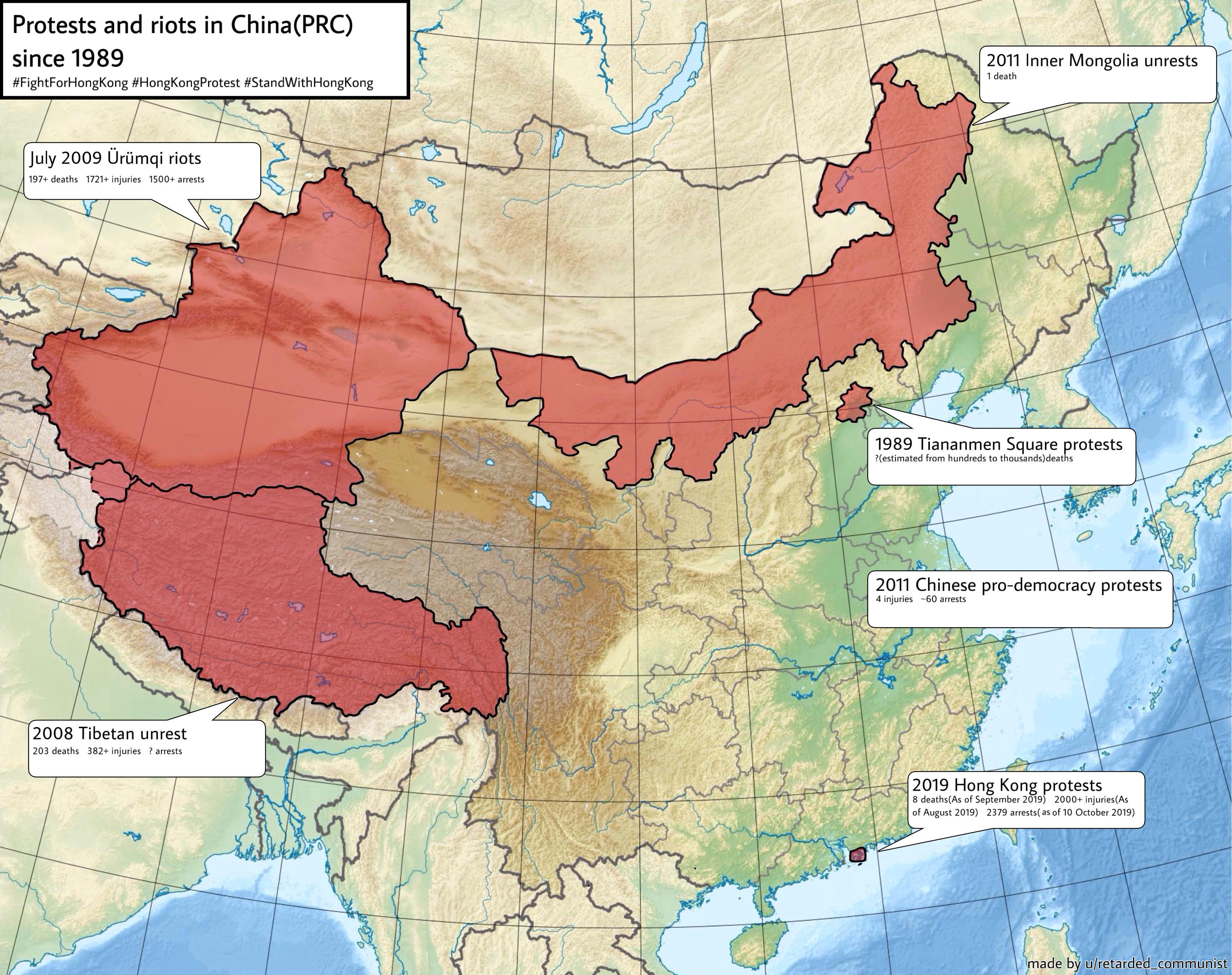Protests and Riots in China Since 1989 Map


Alex Cartwright
Senior Cartographer & GIS Specialist
Alex Cartwright is a renowned cartographer and geographic information systems specialist with over 15 years of experience in spatial analysis and data...
Geographic Analysis
What This Map Shows
This visualization illustrates the geographic distribution of protests and riots in China since the pivotal year of 1989. The map pinpoints significant events across the country, reflecting the various movements that have arisen in response to political, social, and economic grievances. What’s particularly striking is how these incidents are not confined to major urban centers but are spread across diverse regions, demonstrating widespread discontent and the complexities of China's socio-political landscape.
Deep Dive into Protests and Riots in China
Since the Tiananmen Square protests in 1989, which tragically ended in a violent crackdown, China has witnessed a variety of protests and riots fueled by a range of issues. These events often stem from grievances related to government policies, local corruption, labor rights, environmental issues, and ethnic tensions. Interestingly, while the Communist Party of China maintains strict control over public expression, the sheer number and variety of protests indicate a growing undercurrent of dissent.
One of the most significant aspects of these protests is their geographical diversity. For example, labor strikes in the industrialized regions of Guangdong reflect the frustrations of workers facing poor conditions and inadequate pay. In contrast, protests in Xinjiang often relate to ethnic tensions and human rights abuses against the Uyghur population. This juxtaposition highlights the multifaceted nature of dissent within the country.
Statistically, reports suggest that there have been hundreds of thousands of protests in China over the past few decades, with specific peaks around 2008 (during the Beijing Olympics) and in the years leading up to and following the 2011 Arab Spring. The Chinese Academy of Social Sciences estimated that in 2010 alone, there were about 180,000 instances of mass incidents, a term used to describe protests or riots. The government often classifies these events as threats to national stability, leading to increased restrictions and crackdowns.
Interestingly, social media plays a pivotal role in mobilizing protests. Activists use Weibo and other platforms to organize, share information, and document events, despite government censorship. This digital aspect has allowed protests to grow and spread more rapidly than in the past, creating a sense of interconnectedness among various movements.
Regional Analysis
Analyzing the map, we can see that protests are not uniformly distributed across China. Eastern provinces such as Jiangsu and Guangdong have seen a higher frequency of labor strikes, largely due to their industrial economies. For instance, in 2014, a massive strike at a Honda plant in Guangdong involved thousands of workers demanding better wages and working conditions, reflecting broader labor unrest in the region.
Conversely, in Tibet and Xinjiang, protests are often rooted in ethnic and religious issues. The Tibetan protests, particularly around the anniversary of the 2008 uprisings, highlight the ongoing struggle for cultural autonomy and human rights. In Xinjiang, the protests often take the form of resistance against government policies aimed at assimilating the Uyghur population, leading to significant unrest in the region.
What's fascinating is that rural areas also see their share of protests. Farmers protesting land grabs and environmental degradation, particularly in provinces like Henan and Hubei, often face violent responses from local authorities. These rural protests, while less publicized, are crucial to understanding the full scope of discontent in China.
Significance and Impact
Understanding the landscape of protests and riots in China is essential not only for grasping the current socio-political environment but also for predicting future trends. The Chinese government's response to these protests often includes a mix of repression and reform, as authorities attempt to quell dissent while also addressing some underlying grievances to prevent larger uprisings.
The implications of these protests extend beyond China’s borders. Internationally, these movements can impact China's diplomatic relations, especially with countries that prioritize human rights. Furthermore, as the younger generation becomes more educated and socially aware, we might see an increase in activism, potentially leading to more frequent and larger protests. Have you noticed how global movements can influence local actions? This interconnectedness could shape the future of governance and civil rights in China.
In conclusion, the map detailing protests and riots since 1989 offers a vital glimpse into the evolving landscape of dissent in China. It serves as a powerful reminder of the ongoing struggles faced by citizens seeking to voice their grievances in a complex socio-political environment.
Visualization Details
- Published
- October 31, 2025
- Views
- 8
Comments
Loading comments...